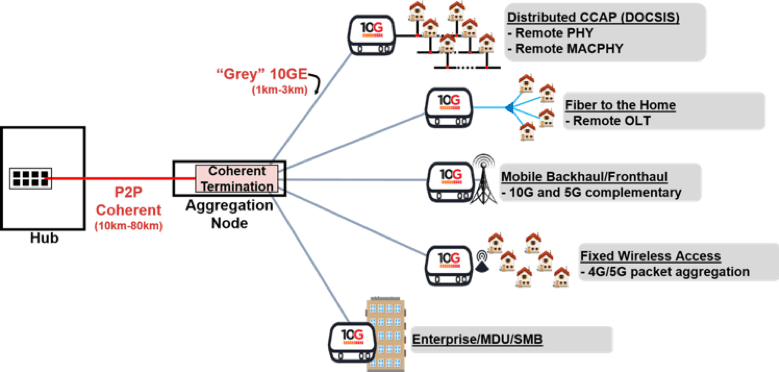10G
The 10G Converged Optical Network

Those of you who’ve heard me speak on the topic of Point-to-Point (P2P) Coherent Optics have probably noticed that I’ve placed this technology in the context of the cable industry’s move to Distributed Access Architectures, and as a result, the dramatic change in the way networks are architected. It’s a change that I would argue is as dramatic as the move from single-direction all-coax networks to bidirectional hybrid-fiber coax (HFC) networks that occurred a couple of decades ago. And it’s a change that enables a range of new services and business opportunities.
The cable industry’s roadmap to the 10G Platform is making that change—and its implications—clearer.
As most followers of these blogs are likely aware, the majority of today’s cable systems leverage an HFC network with analog optics: RF signals are generated in a hub or headend, converted to optical, then converted back to electrical at a fiber node for distribution over coax to the home. Broadband service over that network is provided via a DOCSIS® cable modem termination system (CMTS) at the hub or headend, working with a DOCSIS cable modem in a customer’s home; the cable modem provides customers with access to high-speed Ethernet network connections via coax. As a result, high-speed data transmissions over a cable operator’s network are generally only accessible via DOCSIS cable modems connected to the coax portion of the network rather than the fiber portion.
However, that’s now changing.
In her recent blog post, “The Path to 10G: 2020 Update,” our Chief R&D Officer Mariam Sorond talked about the convergence enabled by the 10G Converged Optical Network, which Figure 1 illustrates.

Figure 1: The 10G Converged Optical Network
Although it can take many forms, it’s often assumed that the Aggregation Node with a Coherent Termination Device depicted here (which is expected to sit where a Fiber Node resides today) would be an Ethernet switch. This has dramatic implications for how this network can be leveraged: There’s now a fiber-based Ethernet connection point deep in the network with 100 Gbps or more of capacity and very low latency.
In essence, the cable operator’s core Ethernet network has been expanded deep into the field. Just about anything can be attached to it. And with high capacity and low latency, a host of potential new service offerings becomes possible.
Figure 1 makes just this point: Not only does it depict a Distributed CCAP device (such as a Remote PHY or MACPHY device) connected to the network, but also a Remote OLT, a mobile base station, a fixed wireless access point and a direct enterprise connection. And that’s only a sampling of the nearly endless possibilities, because everything is converged onto a single, high-speed, low-latency, high-reliability fiber Ethernet network.
That’s ultimately what the 10G Converged Optical Network is about: not just providing a network that supports today’s or even tomorrow’s known services but also providing the network on which to enable all sorts of innovative new services that no one has even thought of yet. P2P Coherent Optics—and the move to Distributed Access Architectures—is a key enabler of that.
The various pieces required to support this new reality are starting to come into place: Remote PHY devices are being deployed, and interoperable P2P Coherent Optics technology has been demonstrated, with new equipment to support outdoor deployments expected in the not-too-distant future. If you have new and innovative ideas for ways in which to leverage this emerging new network, please use the contact form below. We’d love to hear from you. Otherwise, keep watching for these blogs to see how things progress.




